#lessons in humanity from a future physicist
Explore tagged Tumblr posts
Text
WIP Re-Intro: Lessons in Humanity from a Future Physicist

Genre: Literary Fiction, Coming-of-Age | Status: Rewriting | Playlist | Pinterest
Way back in the day—I think on my old account, which I lost the password and the email for—, I wrote a WIP intro for Lessons in Humanity from a Future Physicist. Looking back, it’s not up to the standards that I hold now, which is a sign that things have changed for the better. Things have also changed since then.
Lessons in Humanity is my oldest work. This year, it turns ten years old. That’s older than 3/4 of my sister’s kids, older than my relationship, and older than even my own name. It’s crazy to think that I’ve been writing this book for almost half of my life, and crazier still that I keep changing things about it. These are characters I made when I was a lonely, angsty tweenager who was feeling weird things about my gender and place in the world.
The first draft of Lessons in Humanity, which was called We’re All Dead After All, was a disaster of depression that honestly concerns me, looking back at it. I was deeply sad at this time. Things have vastly improved since then, though I still do like a tragic story every now and then.
It’s no longer a story drenched in my own pre-teen depression; it’s a story about growing up and changing. I think that’s what makes it so personal to me; that I’ve been changing things about it as I’ve grown up and changed.
Lessons in Humanity is about Kam Suzuki and his best friend Zach Amsel as they begin their first semester at Miami University (in Oxford, Ohio). While there, Kam has a difficult time adjusting to the change and finds himself crumbling under the weight of some issues he has yet to deal with.
A more literal way to put it is: Kam experiences the absolute Hell I went through (mentally) when I graduated university.
It’s more of a literary fiction character study than something with a big, overarching plot. Think My Year of Rest and Relaxation literary fiction versus The Secret History literary fiction. Nothing big and grand happens in it. It’s a quiet story about a guy slowly wearing himself into nothing and then building himself back up (with the help of his friends). There’s a romantic subplot that I only ended up adding because it felt natural.
I think what makes Lessons in Humanity so important to me isn’t just that I’ve been working on it for almost half my life. It’s also that, whenever I go through a difficult time of change, I come back to it. Case in point: I’m writing this update right now because, in six weeks, the American branch of my company will lay us all off. Lessons in Humanity brings me comfort when I feel directionless because Kam feels the same way. Dare I call it my comfort work.
As a (likely-autistic) trans guy myself, Kam was me before I was even me. For all the time I’ve been writing him, Kam has been a way to understand myself and the things I felt. Of course he’s like me.
My biggest hope with this book is that it does for others what it’s been doing for me. I love Lessons in Humanity when I’m feeling unsure and afraid of change. If it can comfort other people in those times—or any other time—, then I consider it to be a success, no matter what. The idea of Lessons in Humanity from a Future Physicist being someone’s comfort book makes me want to cry.
I haven’t done a full rewrite of Lessons in Humanity since 2020. Since then, I’ve gone to university and gotten (part) of the full experience, and I’m going to add quite a bit of realism to what wasn’t accurate before.
(My husband and I are going to go on a small trip to Oxford, Ohio in October once the layoffs are finished so I can get a little bit of a refresher on the town. I haven’t been in two years, and that was back when I was doing Doordash.)
Kam Suzuki
One of my first ever queer characters, Kam will always hold a dear place in my heart. It’s not that much of a joke when I say that Kam is my self-insert character. When you list out our traits, we look almost the same. And yet, I do take some steps to make Kam a little different from me. I take aspects of people in my life that I love (which I do for all of my characters) that are far different from me and put them in him.
Despite being obsessed with his physical fitness, Kam is someone who doesn’t deal with his problems. He locks them in his chest and lets them claw away at him until he can’t stand it anymore. Unfortunately, that happens to him during the events of Lessons in Humanity. There’s some stuff he’s been holding in for far too long, like his trauma from walking in on his twin brother’s suicide attempt, along with his general hatred of things changing and fear of abandonment.
Kam’s lifelong dream is to work for NASA. He’s been obsessed with space and science since he was a small child, so of course, he’s a Physics major. He’s also the type of person who works himself to the bone for success. (In this way, we are the same.)
Zach Amsel
Something I love about Zach is that it feels like he’s the other part of me. What Kam didn’t get, it seems like Zach got. Zamsel is the type of indie soft boy that I easily catch crushes for, with my “anxious but slutty bisexual” energy and unruly curly hair.
When it comes to Zamsel, I would just like to say: his playlist is composed of a lot of The Front Bottoms. He’s a sad boy who gets into a lot of bad situations with toxic romantic partners that take advantage of him. While I’ve changed the timeline of a couple relationships of his, the fact that he’s willing to get with almost anyone who shows interest in him is equal parts depressing and frustrating. For both everyone in the novel and myself.
Bad taste aside, Zamsel is a sweet guy with an incredible competitive streak. He and Kam have been competing with each other for years now, and they still push each other towards success.
Nikki Espinosa-Jasso
Nikki is a Mechanical Engineering student who shares an art class with Kam and Zamsel. She’s a year older and wiser, a bit jaded, and overall, a little abrasive on the surface, but she has a heart of gold. I think we’ve all met a person like her. Her main love languages are acts of service and getting food together.
She’s receiving what is pretty much a total overhaul. Where she used to be a quasi-mother figure to Kam and Zach, I’ve decided to make her a little more feral and a lot less maternal. Nikki needs to be a more interesting person outside of the boys.
Vic Suzuki
Kam’s brother who is still in high school since he didn’t skip a grade when Kam did. When I first created him, he was your typical 2014-era emo, which has now become a 2024 Tiktok alt boy, I guess. Blue hair, lots of piercings, black hoodies under leather jackets, bold tattoos, bisexuality. He was my gender goal when I created him, and honestly, I’m pretty damn close to it right now.
In the past, Vic was depressed to the point of attempting suicide, which Kam walked in on and was traumatized by. Vic doesn’t know this. He’s gotten better since then, and has far better coping mechanisms. Honestly, he has some of the best mental health in the book, which is a huge change from how he was in WADAA.
He has goals now (that don’t include being dead). Vic is trying to line up a tattoo apprenticeship when he graduates high school.
Gerard Shimmish
Kicked out of his parent’s house for being gay, Gerard has been living with the Suzuki family for about a year and a half. He’s Vic’s boyfriend and best friend, and a general ray of sunshine. We don’t see as much of Gerard as we did in WADAA, which is a shame. Gerard is a character I pour a lot of my optimism into.
His big thing is helping people. He wants to be a social worker or a psychiatrist. Something where he works with LGBT youth like himself.
He’s getting some minor character edits to make him a little more interesting, but overall, I think Gerard’s a sweetheart. I might borrow some traits from my husband to give him some more depth.
Tag List
@aritany, @reininginthefirewriting
Ask to be added to the tag list!
#wip intro#wip re intro#literary fiction#coming of age#novel intro#writeblr#lessons in humanity from a future physicist
19 notes
·
View notes
Text

{{The Birth Number}}
Your Birth Number is calculated from your complete date of birth.
If life is a school where we come to learn all the various lessons necessary for the growth and maturing of the Soul - as we believe it is - then the Birth Number represents what grade we are in.
As we go through our various life experiences, each of us learns certain things along the way. We bring these along with us, as talents and abilities, as we enter into each new life-experience. These are the tools we have to work with as we endeavor to learn the lessons we have chosen to learn throughout each new life-cycle
These talents and abilities are reflected by the Birth Number, indicating what you have already learned throughout your past lives. By using this accumulated knowledge wisely you can make all of your future (or present) lessons easier and more focused.
The Birth Number is a good indicator of the things you are well- suited for as your vocation or career. Generally speaking, if you are happy in your work, you find your entire life to be more pleasant and easier to manage. Lessons are more easily learned when you are in a relaxed frame of mind, without unnecessary discomfort or stress. For this reason, a comfortable vocation can be very important in the fulfilling of your present life's goals.
Remember, the Birth Number indicates the talents and abilities you have brought with you into this life; the tools you have to work with, so to speak, not what you must do.
{{Your Vibrational Pattern}}
It is believed that the lineage of Esoteric Numerology dates back 11,000 years, at the very least. Ancient man believed numbers were divine because of their perfection. Numerology has been acknowledged since the beginning of recorded human history, and very probably well before that. However, in its modern form, it was developed around 2500 years ago by a Grecian philosopher by the name of Pythagoras.
Principally, Esoteric Numerology is the study and philosophy of number vibrations and the manner in which they affect not just people but the entire Universe. Physicists and mathematicians have long known that, ultimately, everything can be expressed in numbers. Everything is mathematical and vibrational in nature, thus—the study of Esoteric Numerology. Although numbers don’t impact people, directly, they do reflect the object lessons we have descended into this material world to learn and the way in which we present ourselves while we learn these lessons.
The study of Esoteric Numerology is based upon the belief that the human Soul is given a body, for the opportunity to live in this world for the sole purposes of learning and growing. Since virtually nobody ever reaches anything even remotely resembling perfection, or has enough time , in one lifetime, to experience everything this world has to offer, we must return time and time again, in a cycle of life situations, each aimed at a gradual, progressive Soul-growth: a self-perfecting which eventually leads to spiritual maturity. This allows us to then move on to a higher level of awareness ... a higher plane of existence, so to speak. This process is, of course, known as reincarnation or rebirth.
The Esoteric Numerologist believes that vibration is the motivating force used by the Universe to energize everything—including you and me. If we can gain the knowledge to understand the vibrational currents at work in our lives, we can then learn to cooperate with them and, by so doing, increase our ability to learn and grow, at a faster and easier rate.
Learning to understand and cooperate with the vibrational patterns at work in your life, with a tool such as your Numeroscope, can provide you with just such a map of your pre-planned but forgotten destination in life.
2 notes
·
View notes
Text
Oppenheimer: The Future of Man
Note on the text: I used American Prometheus: The triumph and Tragedy of J Robert Oppenheimer by Kai Bird and Martin Sherwin as published in 2006 by Vintage Books
What an interesting person "The father of the atomic bomb" J Robert Oppenheimer was. He was multifaceted individual who was uniquely qualified- as a scientist and a man- to lead the world into the atomic age. One of the many lessons that I learned from his life is just how important it is for us to create a nurturing environment where we can live in peace and harmony if we want to bring the best out of ourselves as humans in the atomic age.
We see the seeds of this philosophy being planted in the very beginning of Robert's life. His parents, Julius and Ella, loved him and his younger brother Frank, a renowned physicist in his own right, as well as each other, a lot and they created a loving and nurturing home where Robert and Frank could grow and develop into the exceptional young men that they eventually became. A letter which Ella wrote to Julius just before they got married says it all: "I do so want you to be able to enjoy life in its best and fullest sense, and will you help me to take care of you? To take care of someone whom one really loves has an indescribable sweetness" (11). To her and Julius it was important that their boys lived full lives in the best sense of the world and they did their best to create a loving environment where Robert and Frank would feel encouraged to try things, explore who they were as people, and become the best versions of themselves.
To that end, they had no qualms about supporting their boys and encouraging them to pursue whatever their interests were. They would give their boys "every opportunity to develop along the lines of [their] own inclinations and at [their] own rate of speed" (15). Robert later said that he thought his father was one of the best and most tolerant people he had ever met, and that "his idea of what to do for people was to let them find out what they wanted" from life (15). When Frank became interested in Chaucer, his parents got him a 1721 edition of Chaucer's works, and later when he expressed interest in playing the flute the hired one of America's leading flutist, George Barer, to tutor him. Similarly, when Robert was 12 he started developing an interest in geology and would write to local geologists about the rocks he had found. This lead to a really funny moment which shows just how fiercely his parents loved him and how much they stood by him. Unaware of how old he actually was, the local geology club, which was made of experts in the field, invited the 12 year old to present a reports on some local rock formations which he had been studying. Instead of informing the club of its mistake, Julius
encouraged his son to accept the honor [and] on the designated evening Robert showed up at the club with his parents who proudly introduced him as 'J Robert Oppenheimer'. . . . [Although he felt] shy and awkward [at first], Robert nevertheless read his prepared remarks and was given a hearty round of applause. Julius had no qualms about encouraging his son in this adult pursuit (15).
The result of being raised in such a loving and nurturing environment is that Robert got to explore who he was and become the best version of himself. This allowed him on the one hand to become uniquely great in his field in a way that he couldn't have otherwise, and it also gave him a tougher skin when it came to dealing with the world. People who are confident in themselves tend to care less about what others think of them. It gave him a strength to face the world that he would not have otherwise had. So while on the outside the shy, weird, and slightly sickly looking Robert might have brittle, he actually had a strong inner toughness and a "stoic personality built of stubborn pride and determination, a characteristic that would reappear throughout his life" (21). The only way he could have gotten that type of resilience was by growing up in a nurturing environment where he was allowed to become his best self.
You see similar instincts at play when he started teaching graduate students physics at Berkeley. Because although he could be harsh at times he was much more interested in creating a nurturing environment where his students could become the best versions of themselves. He engendered a spirit of collaboration instead of intense competition where students felt emboldened to go to him, and each other, for help, and where people were encouraged to explore, and develop, their own talents and become the best versions of themselves. Just look at the story that one of his graduate students, Joseph Weinberg, tells about how he was able to uniquely nurture the students around him to become their best selves. One day, while in Oppenheimer's office Joseph was
rummaging through papers stacked on the trestle table in the center of the room. Picking out one paper, he began reading the first paragraph, oblivious to Oppie's irritated look. 'This is an excellent proposal' Weinberg exclaimed, 'I'd sure as hell like to work on it.' To his surprise Oppenheimer replied curtly 'Put that down where you found it.' When Weinberg asked what he had done wrong, Oppenheimer said 'That was not for you to find'. A few weeks later, Weinberg heard that another student who was struggling to find a thesis topic had begun work on the proposal that he had read that day. 'The student was a kind and decent man', Weinberg recalled. 'But unlike a few of us who enjoyed the kind of challenge that Oppenheimer threw out like sparks, he was often baffled, and nonplused, and not at all at ease. Nobody had the courage to tell him 'Look, you're out of your depth here.' Weinberg now realized that Oppie had planted this thesis problem for this very student. It was a distinctly easy problem. 'But it was perfect for him', Weinberg said, 'and it got him his PhD'. . . . Weinberg insisted years later [that] Oppie had nurtured this student as a father would have treated a baby learning to walk. 'He waited for him to discover the proposal accidentally on his own terms, to pick it up, [] to express his own interest in it, to find his way to it. . . . He needed special treatment and, by God, Oppie was going to give it to him. It showed a great deal of love, sympathy, and understanding.' The student in question, Weinberg reported, went on to do great work as an applied physicist (170-171).
It was this same attitude that made him an effective leader of the Manhattan Project at Los Alamos, New Mexico. He was an expert at creating a nourishing environment where everyone, from the leading scientist down to the lowest custodian, could do their best work and actualize their potential. He proved to be not only a great scientist, but a great motivator and leader. A lot of the problems that he dealt with on the Project were more personal than they were scientific. So whether it was at home, at school, or at the Manhattan Project, Oppenheimer understood the importance of creating a safe, loving, nurturing environment where people could become their best selves.
Now before going into how this same philosophy showed up in Oppenheimer's life after the bomb dropped on Hiroshima and Nagasaki, it is important to take a moment to look at what Oppenheimer's idea of community was and how it developed over time.
When he was in his early twenties, he read a line from Marcel Proust that stuck with him for the rest of his life: "Indifference to the pain one causes is the [most] terrible and permanent form of cruelty" (585). He was always aware of the obligation he had to make the world a better place, in whatever way he could.
His social conscious was something that was fostered in him as a young man. He went to school at the Ethical Cultural Fieldstone School from the ages of 7 till he graduated high school in 1921 at the age of 17. At the Ethical Cultural school he was surrounded by
men and women who thought of themselves as catalysts for a better world. In the years between the turn of the century and World War I, Ethical Cultural members served as agents of change on such politically charged issues of race relations, labor rights, civil liberties, and environmentalism. . . . Members [of the school community] were pragmatic radicals committed to playing an active role to bringing about social change. They believed that a better world required hard work, persistence, and political organization. In 1921, the year Robert graduated from the Ethical Culture high school, [its founder Felix] Adler extorted his students to develop their 'ethical imagination' to 'see things not as they are but as they might be'" (19).
In the early part of the 20th century members of the school community went on to do things like found the NAACP and the National Civil Liberties Union (the forerunner to the ACLU) and conduct labor strikes. So Robert grew up around people that were very socially conscious. These values only really started to show themselves in the 1930s when he became more politically active. He was never interested in politics per say, but in the ways in which he could help improve people's lives:
Beginning in 1936. . . my interests began to change. . . . I had a continuing, smoldering fury about the treatment of Jews in Germany. . . . I saw what the Depression was doing to my students. Often they could get no jobs or jobs which were wholly inadequate and through them I began to understand how deeply political and economic events could affect other people's lives. I began to feel the need to participate in the life of the community (114).
It was at this point became "devoted to working for social and economic justice in America" and abroad (152). It is at this point that we see his desire to create a nurturing environment where people can thrive reach the worldwide stage.
Fast forward to 1945. The bomb has exploded. In the early morning of July 16th, Oppenheimer becomes "death, destroyer of world" and with that he has to take on the responsibility of how to properly introduce the world to the power of the atomic bomb (309). It was his responsibility to help build a society of human beings that could not only survive but thrive in the atomic world.
Although he was aware of how powerful the atomic bomb could be, seeing the devastation that his creation caused for the people of Hiroshima and Nagasaki really inspired him to take action. His feelings towards the bomb were initially very complex. He was never fully behind the idea of developing an atomic bomb, but he believed that it was his duty to do so before Hitler did. He thought that giving a genocidal maniac like Hitler such a powerful weapon would be the worst of all possible outcomes. But after Hiroshima he wasn't sure anymore: "We have made a thing, a most terrible weapon. . . a thin that by all standards of the world we grew up in is an evil thing" (323). More than that, he saw the explosions at Hiroshima and Nagasaki as mankind's final warning: that we must come together in a spirit of brotherhood and give up all our petty differences and hatreds or else we will die: "The people of this world must unite or they will perish. This war that has ravaged so much of the earth has written these words. The atomic bombs has spelled them out for all men to understand" (329). If humans are to reach their potential, then they have to create the loving and nurturing environment that they need now for such a change to take place.
Just like he did with his students, and like his parents did with him before, he believed he needed to help create a loving environment where humanity as a whole could evolve and become the best version of itself. HIs particular idea was to establish what he called "The Atomic Development Commission" which would be an international coalition dedicated to making sure that no nation would ever use atomic energy to build another bomb. It would ensure that atomic power would only be used to positive things that could be used in peacetimes. The key here, obviously, is that every nation involved in the Commission had to collaborate with each other. There could be no secrets, no underhanded dealings, everyone had to deal with each other in open and honest ways. He would spend the rest of his life trying to convince the world that this was the only way to actually move forward.
And so we find ourselves back to the place we started. It started with Ella and Julius creating a safe space where their kids could grow and flourish, continued into Robert's professional life where he attempted to create a nourishing environment where his students and co workers could become their best selves, and ended here- with Robert trying to create a safe and loving world where mankind could evolve into its best self. Love, in short is the answer. We need learn how to love each other and live with each other or else we are doomed. We'll see what happens next.
2 notes
·
View notes
Text
One of the biggest lessons that Einstein’s special theory of relativity teaches us is that, in reality, this world is four-dimensional. Although humans experience a three-dimensional world in which time seems to flow, reality itself exists in space-time - in which time is a dimension on a par with space.
If time is just another dimension, then the entire history of the universe from beginning to end is spread along this time line. The past still exists and so does the future. Our human perception of an eternal present which seems to travel along in the future direction is an illusion: that’s not the way the world is at all. Physicist Hermann Weyl expressed the four-dimensional view of things this way: “The objective world simply is; it does not happen.”
Nick Herbert, Ph.D.
0 notes
Text
Book #191 - Die Physiker by Friedrich Dürrenmatt
(I'm going to refrain from ranting about how catastrophically my former teacher misunderstood this play; because this is the only school reading I ever did voluntarily, and I still like it.)
If dry, dialogue-based comedy is your thing, give this play a shot? It's a very interesting time capsule, theme- and setting-wise, of the Atomic Age circa 1960. You just have to be okay with a bit of bleak absurdism. Also, maybe read his essay "Modell Scott" as a companion piece, I found it insightful.
Aging is a very interesting thing, for art. The Physicists speaks of science corrupted, not by its methods, not by its own, noble aims taken down sinister paths, but by what conventional power might, can, and will do with it. It is patently obvious how scared the play is of the atom bomb, drawing from it the lesson that scientific advancement may have reached, if not already overshot, the limit of what humanity can handle, and that science will need to be reigned in and restricted in the future, in order to prevent bigger disaster.
Which, you know, is an understandable conclusion to reach from two levelled cities. And I guess I just never thought about how that conclusion has aged... not in terms of good or bad, mind you, but in terms of... how has the popular image of a good scientist changed since then, and why?
Today's art and pop culture often depicts science as (part of) the solution to countless global crises, something that isn't listened to enough, something that should be heeded by the powers that mostly ignore it, and provided with resources and the independence to do the right and noble thing (which is science). And that has grounding in reality, too - in anti-vaxxers and mask protests, in climate change denial and terfism, aka people who ignore science and make up their own reality.
Hell, 1961 was pre moon landing... Maybe The Physicists' idea has always been temporary. Or maybe we have gotten used to nuclear power and now can no longer imagine what other horrible, weaponizable thing science could discover.
I currently don't have the brain capacity to make an entire essay out of this, but suffice it to say that this is... fun to contemplate.
1 note
·
View note
Note
Omg Alex you're so sweet!!!! I recommend @bardicbeetle & @cwritesfiction as well--two big cornerstones of my writeblr experience. Chris does a lot of fun writeblr interaction stuff in particular.
If you're interested in my writing, I'm currently working on 3 different projects (ADHD for the win!): Body, (Demon) Hunting for Love, & Lessons in Humanity from a Future Physicist. All of them are incredibly queer (Body is my Trans Manifesto). I also write (eye) horror fantasy, Weird fiction (best genre, in my opinion), and short stories. And vampires. Lots of vampires.
hello, do you have any recs for other writeblrs to follow, especially if their wip's are targeted at adults and include queer characters/romances?
gosh, it feels like it's been a Hot Second since i've been an active part of a writeblr community like we had in its heyday but off the top of my head in no particular order: @ghostcasket (naturally) @reininginthefirewriting, @writeblrfantasy, @magic-is-something-we-create, @magnus-sm-writes,
@ashen-crest, @abalonetea, @howdywrites, @yvesdot, @albatris,
@carnivalls, @zmwrites, @mjjune, @moonshinemagpie, @badscientist,
and others i am 100% forgetting at the moment (please use this post to rec others and if i remember any more i'll add them in reblogs!).
(does anyone know where @fortunatetragedy went??)
137 notes
·
View notes
Text
project
STORY
a description, either true or imagined, of a connected series of events
TALE
A tale is a story, especially one that's full of creative embellishments. You can read a tale from a book, or tell a bedtime tale to the kids you're babysitting. Tales can be true or fictional, but they generally consist of a narrative, with a beginning and an end, made more interesting and exciting with vivid details.
SCIENCE FICTION
is fiction that either explores mankind's relationship with technology/scientific advancements, such as Isaac Asimov's I, Robot, or uses a science fiction framework to offer up social commentary, such as Ursula K. Le Guin's The Left Hand of Darkness.
SCIENCE FICTION STORY
A long time ago, in the year 2020, the oceans had dried up almost completely. Moreover, rivers had turned into barren lands, and humanity was on the verge of extinction due to water scarcity. Fortunately, at that time, a group of scientists started developing a revolutionary machine. This invention would allow humans to skip using water for bathing while maintaining hygiene, eradicating bacteria and body odors simultaneously. This innovative device, named "InAqua," utilized nanotechnology to break down bacteria and neutralize body odors without the need for water. Thus, people could stay clean and fresh without wasting water on traditional showers and baths.
Despite this advancement for the world, scientists knew they needed to do more than just preserve water; they had to correct the mistakes that had led the world to this critical point. With the help of the brilliant physicist and quantum mathematician Dr. Marck Wright, they built a time-travel device. This would enable them to intervene in key moments in history to stave off the misuse of water. They traveled to the year 2000, a time when water wastage was still a global concern. Their initial task was to persuade nations worldwide to adopt the use of InAqua, thus conserving large amounts of water that would have been otherwise used in people's daily bathing. Additionally, this water could be purified and used for drinking.
However, just when the scientists believed they had accomplished their mission, they discovered that a mega-corporation from the future was manipulating InAqua technology for its own benefit, exacerbating water scarcity. Consequently, they decided to travel to the future to confront this corporation and halt its malicious plans. They arrived in the year 2050, infiltrated the corporation's headquarters, and dismantled its operation. However, they realized that the true cause of the water crisis was not only mismanagement of resources but also humanity's lack of awareness and empathy. As a result, they embarked on one last mission: to travel to a distant future where Earth had fully recovered. They aimed to bring back evidence that a better future was possible if humanity learned to value and conserve its natural resources.
The team returned to the present with advanced technology and knowledge of how to prevent the world's apocalyptic future. Eventually, Earth was not merely saved from drought; it was revitalized. Consequently, lush green forests once again stretched toward the sky, rivers flowed freely, and the oceans teemed with life. The air was filled with the fragrance of blooming flowers, and the world resonated with the harmonious melodies of rejuvenated wildlife. Thanks to the lessons learned, humanity, having internalized the invaluable lesson of responsibility, not only thrived in this revitalized world but also actively participated in ongoing preservation efforts. Through dedicated care and mindful practices, they ensured a lasting legacy of harmony and sustainability for future generations.

I created this image with the help of Canva, which has an artificial intelligence that generates images based on the description provided. In this case, I asked it to create a machine for bathing without water, and this was the image it created.
VIDEO LINK
References.
A Beginner’s Guide to Science Fiction | The New York Public Library. (2019, January 2). The New York Public Library. https://www.nypl.org/blog/2019/01/02/beginners-guide-science-fiction#:~:text=In%20short%2C%20science%20fiction%20is,The%20Left%20Hand%20of%20Darkness.
story. (2023, October 11). https://dictionary.cambridge.org/dictionary/english/story
Tale - Definition, Meaning & Synonyms. (n.d.). Vocabulary.com. https://www.vocabulary.com/dictionary/tale#:~:text=A%20tale%20is%20a%20story,and%20exciting%20with%20vivid%20details.
0 notes
Text
'The Manhattan Project was essentially a collective of brilliant American physicists united for the sole purpose of using science to create a bomb capable of destroying the entire planet. Never has so much raw brain power been dedicated to such a monstrous purpose. Oppenheimer, the movie, reveals that the physicists involved acknowledged this horrific possibility.
Oppenheimer reassured his boss, Gen. Leslie Groves, that the chances the test detonation of the bomb would destroy the world were “near zero.” Not “zero.” Nevertheless, they plunged ahead because they believed the potential rewards outweighed the risks.
Oppenheimer, adapted from Kai Bird and Martin J. Sherwin’s brilliant book, American Prometheus, is currently blowing up in theaters around the world. (Sorry; I couldn’t resist.) The explosive film sparked furious debates about what the movie means in hindsight.
At its core, Oppenheimer is a lesson about unintended consequences. Unlocking nature’s secrets can backfire, and as Steve Wozniak, cofounder of the Apple computer, stresses, “When engineers create something…that creation could be used for bad or good. Like the atomic bomb.” Such is the promise and perils of science.
In “Andrea del Sarto” Robert Browning wrote “…a man’s reach should exceed his grasp, / or what’s a heaven for?”
The scientific method brings changes and improvements to everyday life. But these advances occur well before their potential consequences are known.
Oppenheimer believed the atomic bomb would forestall future wars. He also opined that, although possible, he was “fairly certain” that the nuclear explosion could be contained and would not destroy the entire planet. He was right about one claim, and profoundly wrong in the other.
The devastation that the bomb detonation visited upon Japan is well documented. Less well known is the devastation United States citizens suffered. The ghastly impact the fallout from the cataclysmic explosions had on the lives of Americans living in any proximity to the explosion continues to this day.
The Trinity test was conducted on March 17, 1953. In Las Vegas, St. Patrick’s Day always arrives with a bang. But never like it did 70 years ago when the physicists detonated the 16-kilo-ton atom bomb atop the Nevada Proving Grounds, a mere 65 miles north of the city. To determine what effects the bomb would have on people within the range of the blast, the government constructed an entire fake town within a couple of miles of the test site. It was populated entirely by mannequins. In a macabre twist, the workers who constructed the fake town referred to it as “Doom Town.”
I have viewed the iconic black and white video of the impact the blast had on Doom Town. One test house was built a mile from ground zero, which, it turned out, was not nearly far enough away. The video shows the house being seared by the power of the nuclear flash; it is completely blown away by the force of the pressure wave.
No official records of the fate of mannequins used in Doom Town appears to exist. All we know for certain is that the mannequins were taken from the test site and were subsequently used as window dressing at a JCPenny store as silent, glowing “evidence” of the bomb’s power.
It turns out that the government could have gotten more reliable data by examining the effects the radiation fallout had on real people living in and around New Mexico. Hundreds of New Mexicans were harmed during the Trinity test. As Tina Cordova, a seventh generation New Mexican, wrote last month in The New York Times, “[t]he people of New Mexico were the first human test subjects of the world’s most powerful weapon.”
She continues, “[t]he area of southern New Mexico where the Trinity test occurred was not, contrary to the popular account, an uninhabited, desolate expanse of land. There were more than 13,000 New Mexicans living within a 50-mile radius. Many of those children, women and men were not warned before or after the test. Eyewitnesses have told me they believed they were experiencing the end of the world. They didn’t reflect on the Bhagavad Gita, as Oppenheimer said he did. Many simply dropped to their knees and recited the Hail Mary in Spanish.”
In 2005, Ms. Cordova co-founded the Tularosa Basin Downwinders Consortium, which works to bring attention to the negative health effects of the Trinity test. Tragically, New Mexicans exposed to radiation fallout from Trinity have never been eligible for compensation under the Radiation Exposure Compensation Act. This, despite thousands of unusual cases of cancer that continue to plague New Mexicans.
Ms. Cordova’s emotional response deserves the last word in this essay as she laments the physical, mental, and emotional toll Oppenheimer’s “achievement” gifted New Mexicans: “This, too, is the legacy of J. Robert Oppenheimer and the government he worked for. I will never be able to forgive them for wrecking our lives and walking away.”'
#The Manhattan Project#Bhagavad Gita#Oppenheimer#Leslie Groves#American Prometheus#Kai Bird#Martin J. Sherwin#Trinity test#Tularosa Basin Downwinders Consortium
0 notes
Text
Little Quirks Lessons in Humanity Characters Have
Kam:
Everything he says is clear and well-spaced
Unless he’s excited. Then he can speak rapidly and kind of smash things together
Wraps his headphone cord around his finger
Always stands/sits with super good posture
Is an obsessive hand washer
And always has a nice-scented Bath & Body Works hand sanitizer in his pocket/backpack
Likes cleaning other people’s glasses for them
Seeks out pressure for reassurance
Loves space, sci-fi, and NASA and can talk about them for hours
Zach
Stutters on words beginning with w
Rubs the back of his neck when he’s worried
Always pushes up his glasses because the frames are messed up
Slouches a lot
Has a lot of difficulty raising his voice
Can only pay attention when he has his shoes on
Plays the ukulele but can’t play in front of other people because he gets too nervous
Twists the bottom of his t-shirt into knots
Vic
Twists his piercings
Rubs at his wrists
Sticks out his tongue at people when they say something he doesn’t agree with/make fun of him/he’s making fun of them
Gives people Looks
Rolls his eyes a lot
Gerard
Messes with his rosary and wraps it around his hands
And also puts the crucifix in his mouth
Leans his head on Vic’s shoulder
Shoves people
Is extremely paternal to literally anyone/anything
Bakes when he’s stressed
And then stress-eats the baked goods
Has a bad habit of interrupting conversations with random unrelated interjections
Ruth
Uses a lot of large words in her sentences without thinking/providing context
Dog-ears her books
Wears skirts/dresses in bad weather, seemingly without caring about it
Carries clear purses/backpacks
Refers to her estrogen as “titty tacs”
Boops people’s noses
Has Shakespeare/Sappho quotes in her social media bios
Steals Jessica’s jackets/shirts
Jessica
Spaces out randomly during conversations
Is always texting someone
Tries taking up as little space as possible
Almost always wears a swimsuit under her clothes in the summertime “just in case”
Gets sidetracked very easily and starts a lot of tangents
Nikki
Always has grease/oil on her jeans
Has at least 3 hair ties on her person at any time. Doesn’t enjoy sharing them
Is apparently impervious to the Alabama heat
Looks at pet adoption websites when she’s sad
Elbows people
Uses intense sarcasm all the time
Kevin
Refers to himself as a fuckboy
Makes up random conspiracy theories just to pass the time
Then actually starts believing in them
Runs his hand through his bangs a lot
Lies about his height
#lessons in humanity from a future physicist#my characters#kam suzuki#zamsel#vic suzuki#gerard shimmish#jessica mcclain#ruth spencer#nikki espinosa-jasso#kevin espinosa#character quirks#my characters are just wildin' all the time
14 notes
·
View notes
Text
The latest arrivals books on my Chernobyl bookshelf
1. G. Kopchinsky, N. Steinberg "Chernobyl: about the past, present and future", 2021
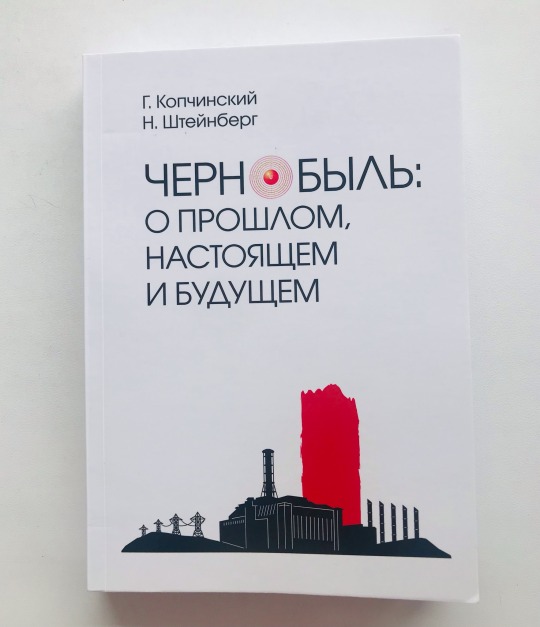
Abstract: The authors are nuclear physicists with extensive experience in the operation of nuclear power plants, management of nuclear energy and regulation of its safety. The book highlights the true role of the Chernobyl NPP personnel in the occurrence of the 1986 accident and the elimination of its consequences, analyzes the causes of the accident and concludes about the lessons to be learned from it.
A very good book. The real causes of the accident are clearly and uncompromisingly analyzed, as well as the authors' opinion on the "official version" of what happened, the report of the Soviet Union at the IAEA meeting in August 1986. Also, big part of the book is devoted to the technical analysis of the RBMK reactor, its features and disadvantages.
I personally really like to read stuff like this.
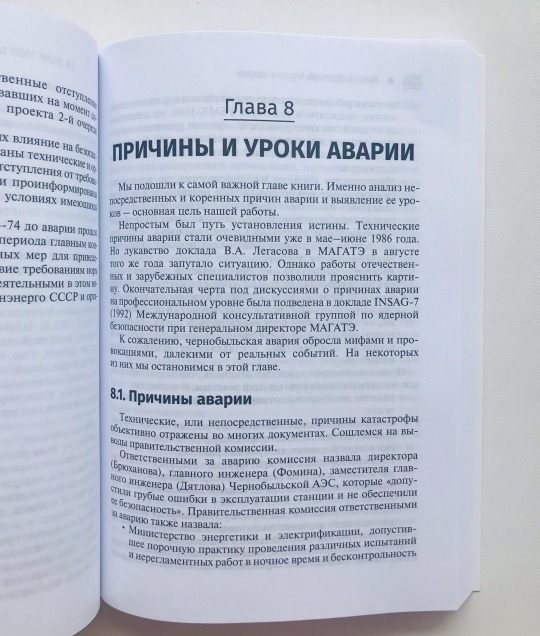

2. L.A. Ilyin "Realities and myths of Chernobyl", 1994
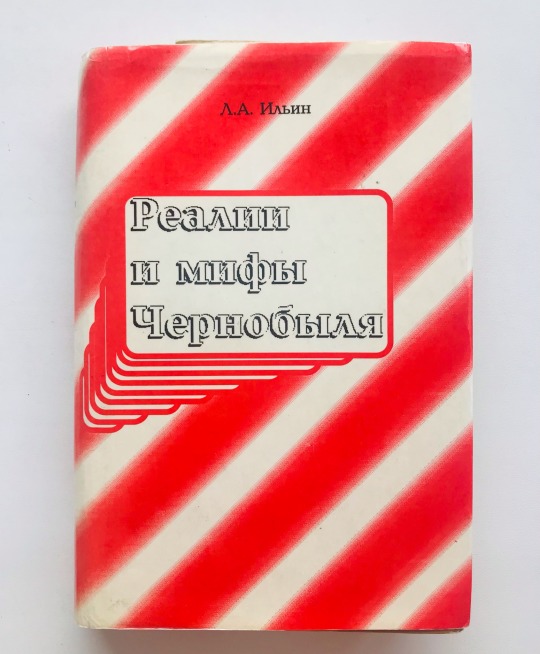
Abstract: The author of the book is Professor L.A. Ilyin, academician of the Russian Academy of Medical Sciences, member of the Main Committee of the International Commission on Radiation Protection. He was directly involved in the liquidation of the Chernobyl accident, being there in the most difficult period after the disaster and was one of the scientific supervisors of work to mitigate its biomedical consequences.
A pretty voluminous book, almost 500 pages in small print, a lot of details, precisely from the medical point of view of the impact of radiation on the human body, as well as criticism of the Soviet government in the field of public health protection and the organization of scientific and practical activities of relevant departments in this area, which even at the time of publication of the books was not brought into proper condition.


3. E.A. Kozlova "The world of the sculptor Nikolai Selivanov", 2004
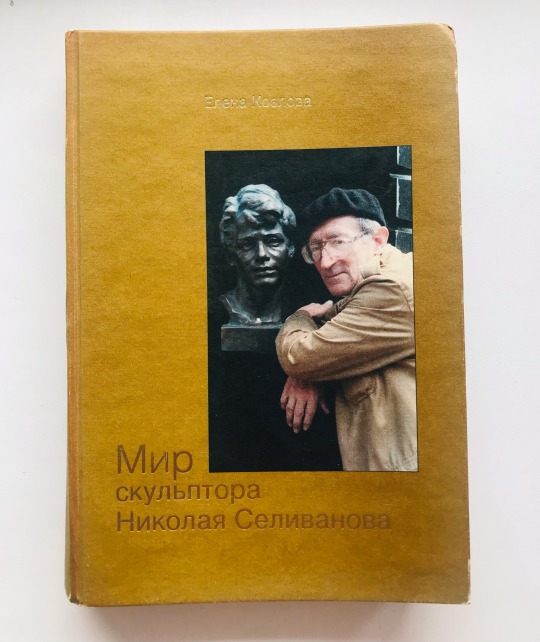
The third book, which I will tell you about today, does not relate directly to the topic of the Chernobyl accident, but it is quite rare and, in my opinion, interesting to study
Abstract: The book dedicated to the 75th anniversary of the birth of the Honored Artist of Russia, sculptor Nikolai Alexandrovich Selivanov, presents with maximum completeness all of his works created over a more than 50-year career, starting from 1952 to 2004. Selivanov is the author of a unique series of portraits and compositions about the great Russian poet Sergei Yesenin and his entourage, portraits of academics, scientists, creators of the atomic fleet, sailors, war heroes, Chernobyl victims, writers and poets, as well as his many friends.
As follows from the description, Selivanov (as well as his son), is the author of all busts and sculptures associated with Valery Legasov.
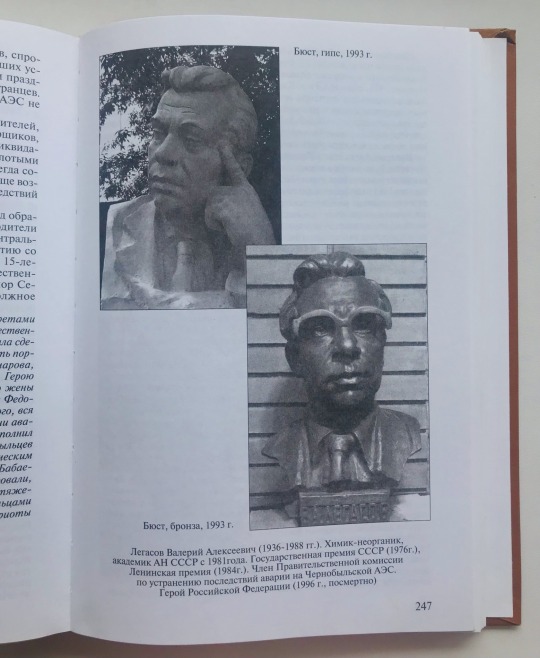
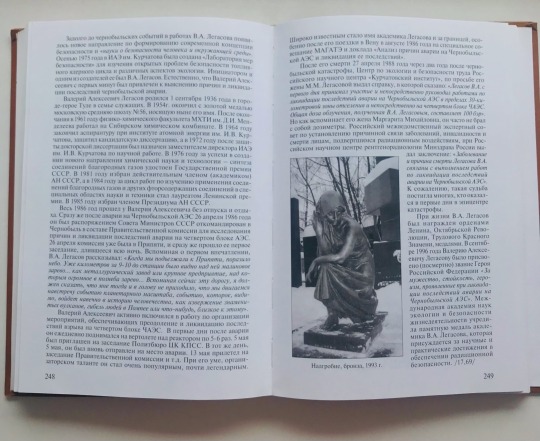

Let me know in the comments if you want to get a more detailed analysis of any on these books, and stay tuned, more interesting things are coming ;)
@elenatria @connihd @leonaevelyn @legasovas @bewareofdragon @johnlockismyreligion @alyeen1 @litttlesilkworm @valerafan2 @odense @natasharedfox @ignalina-c0re @art-is-a-malady @arthoe3105
#valery legasov#chernobyl#valerylegasov#chernobyl disaster#валерий легасов#чернобыль#chernobyl npp#чернобыльская катастрофа#ussr#скульптор#мои книги#о книгах#books#bookaddict#book review
42 notes
·
View notes
Note
Have you noticed over the years that the SJW stuff is seeping into STEM?
Wow, that sounds like a right-wing conspiracy theory to me that must be dismissed and never spoken of again. As long as you ignore all the following examples of social justice seeping into STEM, there is no evidence of social justice seeping into STEM.
In a 82-page training manual titled “A Pathway to Equitable Math Instruction: Dismantling Racism in Mathematics Instruction”, the Oregon Department of Education plans to root out “white supremacy” in mathematics, by not asking students to show their work or placing any emphasis on getting the right answer, which will stop white supremacy from “popping up in the classroom.” The racist implication is that non-white students are incapable of “showing their work” or “getting the right answers,” and so teachers must scrap the academic bar altogether. To fight such white supremacy, math teachers are urged to accept TikTok videos from students instead of math work. The Bill and Melinda Gates Foundation fund the training.
Seattle public schools created a framework to protect children from racist and “oppressive mathematical practices.” Included in this report, educators and students will learn, “How important is it to be Right? What is Right? Says Who?“, “Who holds power in a mathematical classroom?“, “Can you recognize and name oppressive mathematical practices in your experience?” “Who is doing the oppression?” “Who does the oppression protect?”, “Explain how math and technology and/or science are connected and how technology and/or science have been and continues to be used to oppress and marginalize people and communities of color.” The Seattle school district also put into place a K-12 curriculum that encourages students “to explore how math has been ‘appropriated’ by Western culture and used in systems of power and oppression.”
The Department of Mathematics and Statistics at Wake Forest University now offers a “racist and anti-racist uses of math and statistics” class because “The time has come for us to focus on fighting racism and making plans to create a more equitable educational space.” In addition to the new anti-racism math class, the math department at Wake Forest has placed a declaration at the top of its webpage that affirms Black Lives Matter, pledges to try and hire more faculty of color and launch microaggression trainings, and organize a math/stats colloquium on social justice.
The University of California now require ‘diversity contributions’ and statements from future math professors. Applicants are asked to write a statement in which they explain how they will advance the university’s diversity plans. “The Division of Physical Sciences has a strong interest in ensuring that all candidates hired have the professional skills, experience, and/or willingness to engage in activities that will advance our campus equity, diversity and inclusion goals.” The purpose of the diversity statement as a method of evaluating a candidate’s “awareness of the barriers that exist for groups historically under-represented”, “past efforts in diversity and outreach activities” and “future plans to enhance equity, diversity, and inclusion in higher education.” One math professor at the University of California, Davis, wrote in opposition to the required “diversity statements,” referring to them as “using a political test as a screen for job applicants.”
The Mathematical Association of America released a statement in which it argued that mathematics contains “human biases” that can only be corrected by promoting critical race theory to math educators and students.
A math education professor at the University of Illinois argues that the teaching of math subjects such as Pythagorean Theorem perpetuates white privilege because they were developed by Europeans. “Mathematics itself operates as whiteness and who is seen as part of the mathematical community is generally viewed as white.” He also argued there’s no such thing as objective truths.
A Math Education professor from Brooklyn College argued that the "trope” of “2+2=4 reeks of white supremacist patriarchy.” It was also promoted by several academics at colleges around the nation, with another suggesting math should be reevaluated because it was primarily developed by white men. He also complains that “meritocracy” in math classes is a “tool of whiteness.” Teachers who claim color-blindness - that is, they claim to not notice the race of their students—are, in effect, oppressing them. “By claiming not to notice, the teacher is saying that she is dismissing one of the most salient features of the child’s identity and that she does not account for it in her curricular planning and instruction.” He recommends that math teachers incorporate more social justice issues into math lessons, but warns that even “teaching for social justice” can be a “tool of whiteness” if teachers are not sufficiently sympathetic to minority students.
A University of Rhode Island professor claimed that science, statistics and technology are inherently racist “because they are developed by racists living in a racist society, whether they identify as racists or not.” The professor also recently came under scrutiny after condoning an Antifa member killing a Trump supporter last year. After a commenter called him out for his position on his post, he replied “He killed a fascist. I see nothing wrong with it, at least from a moral perspective.”
Duke University has a new computer science course that will focus on race, gender, and class within the world of computing, in order to change the “working environment” of the field. “This course explores the diversity, equity, and inclusion challenges in computing through an introduction to and analysis of various social constructs and their impact on not only computing departments and organizations but also the technologies developed. This course also introduces students to cultural competence in the context of computing.” “We have to change the mindset of a workforce that is overwhelmingly white, Asian and male.”
A group of mathematics professors argued in their published book that math teachers must “live out social justice commitments” to fight privilege in the classroom. Math teachers, “must learn how to advocate for students, self-examine for biases, and strategically subvert the system in which they teach to counteract student oppression,” adding that the development of “political knowledge” is key. “Any amount of connection to issues of equity, diversity, social justice, and power is better than none at all.”
Activists persuaded top science journals to stop work for a day and to validate their claims of “white supremacy” throughout the American science sector. The small group of black academics and scientists demanded that science be “reorganized” for black Americans as they pushed the hashtag #ShutDownSTEM. One of their manifestos demanded that the goal of “justice for black Americans” be prioritized above scientific discovery and objective reality. Another manifesto portrayed all scientists who put science first are racists: “Unless you engage directly with eliminating racism, you are perpetuating it.” In response, two of the leading science publications, Science Magazine and Nature, agreed to not talk about science for a day and instead use their Twitter accounts to post the demands and claims by the radicals.
A physicist at the University of Zaragoza is using cross-dressing drag to “empower” minorities in science and technology fields. In an article on the website, Lady Science, he says drag is still uncommon in scientific fields, because “sexism, racism, ableism and LGBTphobia remain very much alive in academia.”
A recent paper published by a team of various college professors makes the case that STEM courses should be made easier for female students. The researchers argue that “gender” inequities in the STEM majored could be lessened by artificially inflating grades. The study claims that the STEM fields would see an 11.3 percent increase in female students if STEM classes practically erased grading.
A Vanderbilt University professor complained in an academic journal article that the field of mathematics is a “white and heteronormatively masculinized space.” In the article titled Unpacking the Male Superiority Myth and Masculinization of Mathematics at the Intersection, he argues that the apparent “gender gap” in mathematical success is socially constructed. He concludes by expressing a hope that future analyses of gender in mathematics take a more “intersectional” approach, after noticing “intersectional considerations of mathematics achievement and participation shaped by whiteness and sexuality” were left out of many of the studies he reviewed. Intersectionality theory from black feminist thought, he adds, can allow for “more nuanced analyses of gender” and its relation to mathematical performance.
Auburn Drive High School in Canada offers a class in “Africentric” mathematics. It incorporates “discussions about the students’ cultural backgrounds, history and their lived experiences,” all the while teaching them math and associated concepts “through an Africentric lens.”
A scientific journal retracted a professor’s article which criticized hiring based on skin color and sex, leading to apologies from both the journal and the professor’s university. The professor had wrote, “The rise and emphasis on hiring practices that suggest or even mandate equality in terms of absolute numbers of people in specific subgroups is counter-productive if it results in discrimination against the most meritorious candidates.” The journal withdrew the article “amid a backlash” and reassured the professor’s “views do not reflect our values of fairness, trustworthiness and social awareness,” and added they “stand against discrimination, injustices and inequity.”
Two national mathematics organizations are on a mission to prove that math education is “unjust and grounded in a legacy of institutional discrimination.” The National Council of Supervisors of Mathematics and TODOS: Mathematics for All, aim to “ratify social justice as a key priority in the access to, engagement with, and advancement in mathematics education for our country’s youth,” the groups declared in a joint statement, elaborating that “a social justice stance interrogates and challenges the roles power, privilege, and oppression play in the current unjust system of mathematics education and in society as a whole.”
Students at the Claremont McKenna Colleges staged a protest to make it known that objective truth is a ‘white supremacist’ myth devised by “white supremacists” to “attempt to silence oppressed peoples.”
Boston Public Schools have suspended their advanced academic program due to racial ‘equity’ concerns. Acceptance to the program was decided on standardized grade test scores and the successful students would be required “to study in greater depth, with more schoolwork and more home study than the traditional curriculum.” Because 70 percent of students in the program were white and Asian, the program was scrapped. A committee member said she was “very disturbed” by the racial statistics and noted they are “just not acceptable.” The superintendent said “There’s a lot of work we have to do in the district to be antiracist.” Advanced programs for gifted students often are targets either for complete abolition or restructuring due to “incorrect” racial and ethnic demographics.
A recent Washington Post article lamented the fact that biology textbooks contain a disproportionate number of “white men.” “They’re all men. They’re all white, and are written from a very white perspective.”
Cell, a prominent science journal, published a statement accusing their entire discipline of racism. “Science has a racism problem,” they assert, apparently concluding that underrepresentation of a given ethnic group must equate to a deliberate wrongdoing against that group. “Cell stands with our Black readers, reviewers, authors, and colleagues. We are committed to listening to and amplifying their voices, to educating ourselves, and to finding ways that we can help and do better. We alone cannot fix racism.” They go on to list all of the affirmative action changes they can make.
Fordham University’s Political Science department announced it had voted to adopt a new policy that mandates professors must use a student’s “preferred” name and pronouns. The decision was announced just two weeks after student activist groups demanded that the university publicly “resist transphobic rhetoric.” The activist students were inspired to make these demands after reading an article by the New York Times, which reported that the Trump administration had been considering defining sex as “male or female based on immutable biological traits identifiable by or before birth.”
The National Council of Teachers of Mathematics states on its website that “mathematics teachers should “reflect on their own identity, positions, and beliefs in regards to racist and sorting-based mechanisms” and “notice students, learn about the worlds they live in, and build mathematics that comes from these worlds.” They also hold webinars titled “Developing Social Justice Mathematics Activists in Pre-K-Grade 5,” its description states that “mathematics should become a social justice tool that empowers students to mathematically recognize and address oppression they see in their own world.”
Wayne State University, Detroit, dropped math as a graduation requirement and is replacing it with mandatory “Diversity courses.” UCLA also approved a “diversity graduation requirement,” which stipulates that every student in the College of Letters and Sciences take a course about “inequalities based on race, ethnicity, gender, sexual orientation and religion, among other factors.”
Radical Math is “a resource for educators interested in integrating issues of social and economic justice into their math classes and curriculum.” Radical Math boasts over 700 lesson plans, articles, charts, books, and websites that cover a wide range of socio-political issues from redistribution of wealth to racial profiling.
A professor at the University of California-Davis has vowed to “challenge the authority of Science” by “rewriting knowledge” through a feminist lens. Science, she worries, has “earned its epistemic authority through its co-constitution with colonization and slavery,” and therefore “relies on a colonial and racialized form of power.” Not only is science rooted in racism, she alleges, it has been used to perpetuate racism and colonial practices. “At the root of the justification for social inequality then is Western science,” she says, claiming that science’s distinction between “humans and non-humans” has allowed “capitalism to be justified as a natural economic system.
The New York Times published an article highlighting several academics who say “Earth Science has a whiteness problem.” One of them, from Columbia University’s Lamont-Doherty Earth Observatory, said white geoscientists should help increase a “sense of belonging” among non-white groups by “separating their privilege as a white person from their identity as a good person.” Another, who helped create a book club which fellow geoscientists talk about “race and white privilege,” added that earth science classes could be “enriched” by more Native American voices since “Indigenous people have a unique connection to the land.”
University of Wyoming added a diversity course in geosciences meant to address a lack of diversity within the field. The course was the result of a diversity survey conducted by the university in which 67 percent of faculty responded that diversity, equity, and inclusion classes should be required for all students. “The primary goal of the class is to raise awareness that lack of diversity, equity and inclusivity is a problem in our scientific community and in academia in general. The lectures aim to make students think about implicit bias that we often have and don’t recognize and students have the chance to learn from life experiences of scientists from underrepresented groups. The systemic racism that is present in our society also is present in academia. Black, Hispanic, women and LGBTQ scientists are disproportionally underrepresented in the student and faculty population, and students from underrepresented minorities are often the target of microaggressions on campus.”
The National Science Foundation is paying for a multi-million program at Drexel University to help teachers learn how to work social justice into their classrooms. “This project intends to promote social justice teaching, which emphasizes connecting science, mathematics, and engineering instruction to students’ personal experiences and culture. The long-term and far-reaching benefits to society of this project are the potential to document and share sustainable approaches, steeped in the context of social justice.”
The University of Louisville had an opening in its physics and astronomy department, but it ruled out white and Asian applicants. “University of Louisville is an affirmative action, equal opportunity, Americans with disabilities employer, committed to community engagement and diversity, and in that spirit, seeks applications from a broad variety of candidates. The Department of Physics and Astronomy announces a tenure-track assistant professor position that will be filled by an African-American, Hispanic American or a Native American Indian.”
UC Santa Cruz hosted an event called “Research Justice 101: Tools for Feminist Science” where “Participants will be challenged to apply principles and practices of justice to their own work, interrogating questions such as: Who benefits? Who is harmed? Who is most vulnerable? And ultimately, who do we do science for?” The workshop concludes with practical skills and resources for participants to push their research “to be more inclusive, equitable and attentive to social justice.”
A professor at the University of Illinois-Chicago wants others to teach “math for social justice” to help fight the “oppressive status quo” in the United States. He argues that teaching “critical mathematics” isn’t an option for math teachers, but rather a “responsibility to our future.” “We have a responsibility to our future and our planet, to life and all species. What we do in the classroom matters, for today and tomorrow, and the myriad possibilities for resistance and transformation.” “In my work, I argue that K-12 students need to be prepared through their mathematics education to investigate and critique injustice (such as racism and language discrimination) and to challenge, in words and actions, oppressive structures and acts.”
Central Connecticut State University is running a contest, asking students to "express their personal connection to the Black Lives Matter Movement” and reassures students that it’s lowering the racist grammatical standards for the contest. On the website, the school notes “submissions will not be judged on traditional literary or grammatical standards.”
A science education professor at the University of Arizona believes elementary schoolchildren are being taught “heteronormative” and “limited” ideas in science classrooms, and queer theory curricula is the answer. She explores in her lectures how “inviting sexuality into the elementary science classroom” and “queer theory can be useful tools for re-imagining elementary science education and elementary science teacher preparation.”
An academic journal article suggested appointing a “Safety Officer” and rewarding participation in “diversity programming” to combat “gender inequity” at scientific conferences. “Addressing gender inequity should be a primary consideration for all societies hosting conferences, yet many STEM conferences are struggling with gender biases and the understanding that gender inequity also applies to non-binary gender identities and intersectional diversity/overlapping social identities.” They call for the introduction of a gender-based Code of Conduct for all attendees to abide by, appointing a “safety officer” at each scientific conference to make it easier for people to report if they feel they have been subjected to harassment or discrimination, and paying the cost of travel for women who wish to attend the conference.
The director of libraries at MIT argued that tech workplaces need to ditch “Star Trek” posters and other geeky stuff to be more inclusive and welcoming to women. “Replace the Star Trek posters with travel posters, don’t name your projects or your printers or your domains after only male figures from Greek mythology, and just generally avoid geek references and inside nerd jokes. Those kinds of things reinforce the stereotypes about who does tech.” She is a self-described “butch and queer” cis woman and “the work of libraries and librarians is to support feminist research and agendas. She also complained that “A profession that is 88% white means 5000% agony for people of color, no matter how liberal and enlightened you think you are.” She also said we need to have “a f**king reckoning about the pain we cause, and that we need to do some hard work on decolonizing our organizations and our professions.”
PLUS ignore these hundred other examples.
33 notes
·
View notes
Note
Movie script for the Summerfest asks!
Ooh, this is fun!
The most recent sentence is from Lessons in Humanity from a Future Physicist.
"But it’s one thing to know something, and another entirely to experience it."
Thank you so much for sending an ask! :3
3 notes
·
View notes
Text
The Fairly OddFamily (20 Years Later)
By Nakuuro
So this is just a quick rundown of the all of the potential various future adult lives & careers of the six main godchildren of my FOP AU series “The Fairly OddFamily” (which includes Timmy, Chloe, Tootie, Chester, Trixie & A.J.) as they would all will grow up as perfectly functional adults & will eventually loose the memories of Cosmo, Wanda & Poof (but will still retain all of the various life lessons that they learned from them as well). So here’s what I have in mind when I comes to their potential futures 20 years later....
• (Timmy Turner’s Future): Timmy’s Future as a Police Officer is looking pretty good since he essentially grew up looking up to comic book superheroes like the Crimson Chin & Crash Nebula, he ultimately decided to become a hero in real-life by helping others & upholding the law as a upstanding Police Detective for the Dimmsdale Police Department (or DPD) while also staying in touch with all of his friends from time to time as well.
• (Chester McBadbat’s Future): So I imagine that Chester’s future will be pretty interesting because I think that he’ll probably grow up not wanting to go into Major League Baseball since his father was already a hated sports pariah as one of the worst players in baseball history as he’ll probably just wanna follow his passion for music & decide to become a actual musician & songwriter later in life.
• (Anthony “A.J.” James Jr.’s Future): A.J.’s future might be the most exciting as he’ll definitely grow up to be a well-respected scientist in his own right as he’ll probably take of a job as a Astronomer, Engineer or physicist for scientific or even military organizations like NASA, Space X, The Air Force, The Space Force or The Army Corps of Engineers later in life.
• (Dorothy “Tootie” Miller’s Future): With the case Tootie’s future, I’m kinda imagining that she’ll probably go into a career in teaching or childcare since she’ll probably be inspired to be a WAY BETTER mentor, teacher or caregiver then any of the actual adults in her life like her older sister Vicky, her teacher Mr. Crocker & even her own parents as well (and with a childhood like hers, can you really blame her!!)
• (Beatrix “Trixie” Tang’s Future): So with Trixie fully embracing her actual true passions later in life (with the help of Cosmo, Wanda & her best friends) she’ll probably get a career as either highly-acclaimed voice actress, animator/cartoonist, comic book writer or video game developer when she grows up as she’ll also start to make her own small fortune later in life from her own Illustrious career with the added inheritance from her parents to make herself even more rich & wealthier then ever.
• (Chloe Carmichael’s Future): Chloe’s future is the especially bright as she ultimately decided to help the poor & less fortunate by going to medical school to become a medical doctor while also giving back to her community as she also volunteers for philanthropic organizations like Habitat for Humanity, Doctors Without Borders & the Red Cross as well as becoming a well-respected medical professor later down the road.
#the fairly oddparents#fop fanart#nickelodeon#nicktoons#fanfic#alternate universe#timmy turner#trixie tang#tootie#chloe carmichael#fop
23 notes
·
View notes
Text
The Characters of Nisioisin (3)

Trickster - Kaiki Deishuu
Nisioisin often uses and reuses a lot of common character archetypes in his writing. An analysis on his common use of liars, thieves and cheats by comparing and contrasting the differences between Kumagawa, Iichan and Kaiki. More underneath the cut.
A. Defining the Trickster
Already covered in this post.
1. Introduced as a Villain
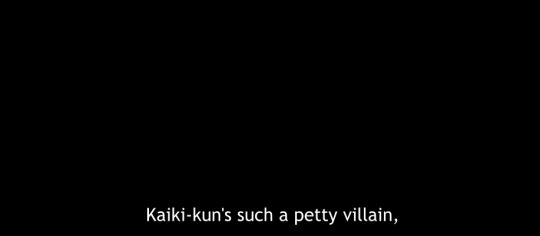
In the story proper Kaiki is introduced to us as the opposite of Araragi. If Araragi is the person who saved Senyjogahara’s heart, then Kaiki is the one who broke her heart. If Araragi is a hero who saves everyone, Kaiki is a callous villain who cons people and doesn’t seem to care about the consequences for those he cons.
Their interaction with every character they both interact with is the opposite. Araragi helps Senjyogahara, Kaiki stole her money and ruined her family home even though they are both positioned as people Senjyo once loved and thought of as a savior. Araragi saved Nadeko from the curse of the snake, whereas Kaiki is indirectly responsible for her being cursed due to selling curse charms to middle schoolers.
Araragi heroically faces off against Gaen to defend his sister, while Kaiki is the one who sold the information about Tsukihi’s location to Gaen in the first place for a quick buck. In every instance, Araragi saves, Kaiki cons.
Kaiki is also one of the few characters that Araragi shows an open disdain for. Araragi who is usually a very passive protagonist, and will go with the flow and talk casually with people who have beaten him half to death and is overly forgiving outright despises Kaiki on sight.
However, it’s important to remember that Kaiki calls himself a villain when making his first introduction to Araragi. He intentionally places himself as the villain so that Araragi can play the hero, even calling him “Manly”, “Cool” and “Grown-up” for doing so, implying again that Kaiki is his opposite. Kaiki however is a liar, and when he calls himself a villain intentionally that also is a lie.
2. Subverts Expectations

Everything we learn about Kaiki in his first introduction in Niseimonogatari is inverted later on. He is a character who exists to play upon other people’s expectations and cast everything into doubt. There’s even a meta aspect to this, originally Koimonogatari was foreshadowed to be Senjyogahara’s narration debut only for Kaiki to take the mantle of narrator from Araragi instead.
Ladies and gentleman, dear readers and all of you who picked up this book expecting Hitagi Senyjogahara to be the narrator have been duped. The lesson you should take home from this is every sentence ever written down by a book is bogus.
-Koimonogatari
Koimonogatari is a book that exists to flip everything set up by Nisei. It is a book where the villain saves the girl (Nadeko) whereas the hero is someone almost completely helpless the whole story (Araragi). You could even say that it’s Araragi’s actions which created the problem for Nadeko, as his complete ignorance of her, and his coddling of her helped push her to want to become a god.
Koimonogatari also starts a turning point in the series, where Araragi who had been a straightforward hero until this part starts to have his character deconstructed. Araragi who is constantly remarked upon as a hero who tries to save everyone, we find out that in Owarimonogatari is not only are there people he never even made an attempt to reach out to and help (Sodachi Oikura), but that Araragi is someone who uses obfuscation and self-deception to cover up his bad traits. He is someone who cares far more for the appearance of being good and helping others, then the actual work of helping others. This is again an idea that is set up in the intro to Koi.
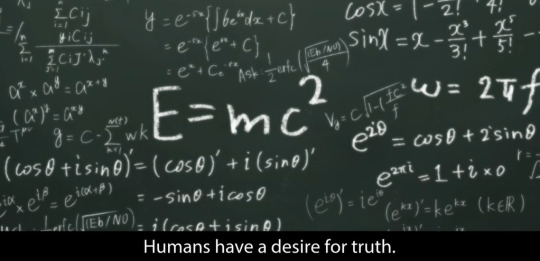

Humans have a desire for truth. or they have a desire to believe what they know is the truth. Kaiki brings up the example of the higgs boson particle that moves faster than light. Plenty of people will find this change in the truth alarming, even though most normal human beings aren’t physicists and won’t even bother to look at the math or data that proves the Higgs-Boson particle and will just read the headlines and take other physicists at their word.
People often care more for the image of something, than the actual thing. That’s true for Araragi as well who isn’t as noble as he appears to be and is for all intents and purposes a normal people. Kaiki is presenting us with the image of himself as a villain, because that is general is easier to accept then viewing himself as a more complicated person. Kaiki also, prefers to view himself as a villain rather than what he really is, which is a failure.
Araragi uses obfuscation to hide his bad traits, but as his foil, Kaiki always desires to hide his good traits. The reason being that Kaiki as a person when he acts with good intentions, things always tend to go opposite of the way he planned them. Kaiki feels in control when he lies, he can control others by lying to them, manipulating them, duping them, but reality is something entirely out of his control. He can try to save someone only to have the completely opposite effect.
“You tore apart the Senjyogahara - and backed her parents into a corner from which divorce was the only way out - because nothing else was going to work, right? You judged that the only daughter would have no future if you didn’t cut her mother off from the family.” “Uh huh, that’s right. I was actually a standup guy. A real sweetheart, just looking out for a kid. I was only putting on a show of being nefarious. You’ve got all the details, don’t you? You’re really well informed. But don’t tell anyone, okay? It’s embarrassing.”
-Koimonogatari.
Kaiki is ultimately someone afraid to be good. That’s his weakness. He knows his good intentions are not guaranteed to produce good results, and he can’t face himself when his failures spiral out of his control so it’s easier to present himself as a villain. Kaiki, much like Iichan only feels comfortable when he’s deceiving everyone around him. He exists to subvert other people’s expectations because it’s a way of grabbing back control, in a world that Kaiki is mature enough to realize by now is completely out of his control.
3. A Lying Liar Who Lies
When Kaiki said every word written down in every book ever are lies, what he’s talking about is narrative. People who see the world in narrative view are applying a lens to reality to make it more palatable and easy to understand for them. Once again, they are preferring to hold onto images and preconceptions, the idea of the truth rather than the truth itself. It’s true that books are like reality, but people will often craft a narrative about reality in order to believe everything has direction, meaning, and a purpose when there is none.
Kaiki is also one of those people. He embraces crafting narratives, and telling lies because it gives him this idea of control he otherwise would not have. Kaiki is someone who doesn’t have a lot of control over his own life. If you take him for his word in the book he has almost no background, no family, he’s legally dead, and he’s a wandering vagabond that never remains in the same place for long. Kaiki’s way of reclaiming that stability and agency is to always craft a narrative around himself wherever he goes. He’s the one in control because he’s conning everyone else around him at all times. He acts like he always has all the cards in his hands, and he’s the smartest person in the room, because he can’t admit how afraid he is of not being that. Of being vulnerable.
Kaiki goes one step further not just by calling himself a liar, but believing the whole world is made up of lies. He’s not just a fake, everyone is. A world of fakes desperately struggling to be real.
“The second you say it out loud to someone, it deviates from your true feelings. All words are lies, it’s all a scam. No matter how true, the moment you utter it, it becomes embellished. Words are only representations, so impurities find their way in. If you want to make a wish, to make it exactly as it is, you absolutely mussn’t say it aloud.” - Koimonogatari
Yes, Kaiki I’m sure this speech has nothing to do with your fear of ever letting your intentions be known.
This is also something Iichan directly calls out in his own struggles with lies, the truth, and the trust in other people you have to find between them.
Hime-chan said everything was a lie. I agree, that must be the truth. But- really. Really, really, really you know. If this world were like what Hime-chan said, if this world were like what I think. We would not be suffering like this. Do you get it? If everything is a lie and there is not one ounce of truth - if ther is nothing of comparison, then everything ends up being the truth, too. - Zareogoto Vol. 3
Kaiki is able to call out Nadeko’s assertion that everyone in the world is a liar, everyone was misleading her and leading her on so easily because that is the same narrative lens he applies to the world to cope with it.
Let’s return to the Senyjogahara household again. Basically imagine you're Kaiki, a homeless man with no family who spends all of his time in luxury hotels and you're watching what looks like an ideal happy household. They are a rich loving family, with a good marriage, and their daughter is basically the school idol. What you Kaiki would call “Normal Law Abiding Citizens” the kind of life he could only dream of.
Traditionally held values say that these people should be happy forever, because they're good people doing the right thing. But the things the world tells us have meaning, are secure, have no meaning at all and easily fall apart.
So, he watches this good family, get struck by misfortune and fall apart. The loving mother sells her daughter to a cult basically, even though she originally joined the cult because of her daughter's sickness.
Now what's an easier story to swallow? That good people do bad things and good circumstances can easily turn bad for no good reason at all.
Or is it easier, and more meaningful to swallow that Kaiki showed up, conned them, caused the parents to get a divorce and therefore he's the villain in the scenario. By being the villain he turned the scenario into a story, he gave it meaning.
The first time I met Hitagi Senjogahara - two years ago, in other words - I thought to myself, What a fragile-seeming kid. Of course, back then Senjyogahara was afflicted with her mysterious ailment, which is why her devout mother had summoned me, flying the flag of the ghost buster as I was. But even without the ailment business, I thought she seemed “fragile.” The impression hadn’t changed. Fragile. [...] Fragile, on the edge of fragmentation. Which is exactly why her current self was a miracle. A mysterious ailment followed by a miraculous achievement - for someone who seemed so breakable to make it so far without ever breaking, not two year sago, not now, for eighteen years - The mother broke. But the daughter Didn’t. -Koimonogatari
So Kaiki says he thought Senjyo and her mother were fragile, but he probably thinks that about everybody. He's cynical and disaffected because he's seen this kind of thing happen again and again. That's why he tells lies, that's why he manipulates, it gives him the illusion of control over a world not only him, but no one else has any control at all.
There are two sides to the story of Kaiki’s perception of Senjyo. First, that people are more fragile than you think they are. Even if you come from a good household, have a loving husband, and have money you can break. The second is that people are less fragile than Kaiki thinks they are. Even if your mother turns against you, you lose your money, status, and family you still might not break. Both of these things are true at the same time, people are both more and less fragile. There are truth, and lies, and even Kaiki is unable to face reality directly because he prefers to stare into lies and shrowd himself in them then ever confront the truth.
4. Themes of Nihilism
Kaiki case believes everything is worthless and everything will be eventually lost so he thinks it's pointless to cling to things. However, that doesn’t have to be an inherently negative idea. Nihilism the rejection of the idea of inherent meaning, is also something that can lead to creating meaning which is where we get existential nihilism.
Nihilism is the precursor to existentialism. To find your meaning in life you have to first reject the meanings that other people give you.
With respect to the universe, existential nihilism posits that a single human or even the entire human species is insignificant, without purpose and unlikely to change in the totality of existence. The meaninglessness or meaning of life is largely explored in the philosophical school of existentialism.
He basically tells Nadeko that he likes money because the value of money is something entirely made up by people and yet it’s still something that has value.
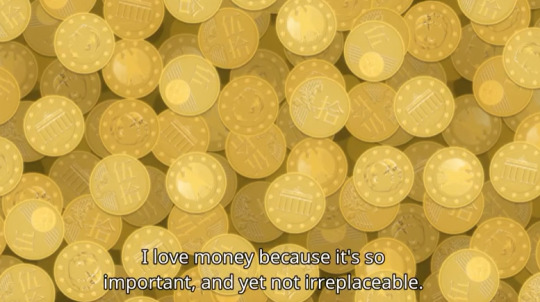
Kaiki loves replacable things while at the same time hating irreplacable ones, because he hates the way people tend to cling to things forever. Almost like, Kaiki himself is someone who always clings to his first love that he lost over ten years ago and doesn’t try to love anyone else, or find anyone else and Kaiki hates himself.
Existential nihilism also means rejecting what society tells you to think has value, because you have to reject first before you can come up with your own meaning. Which is literally exactly what he guides Nadeko to do, he tells her to reject the thing which she thinks gives her life meaning, her love of Araragi and then find a new meaning instead in being a mangaka. and that she can do this because everything is worthless therefore she can try anything.
He also suggests that the work of having to create her own meaning to life, and follow her own dream, will make her far more satisfied than simply following the job of a god which was given to her by someone else.
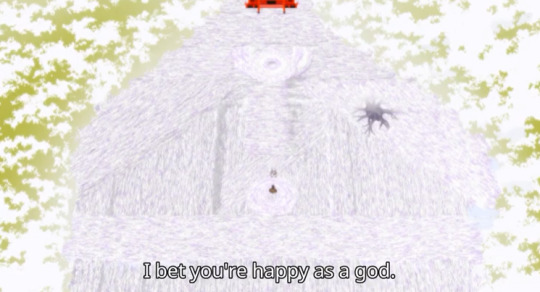
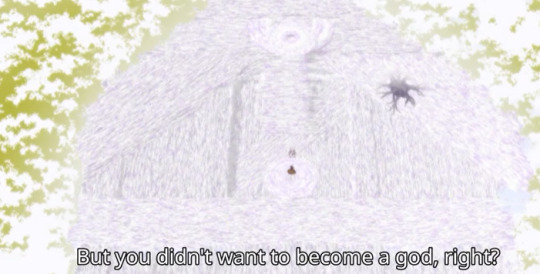
Humans are always changing their minds about what has value and that makes them human and Kaiki thinks that's a wonderful thing, that's existential nihilism, they're always inventing new meaning. Kumagawa is someone who always loses, but he tries again an infinite amount of times, and that struggle to keep trying again and again is what makes him human in Kaiki’s mind. It’s not the result, not the happiness or sadness, but rather in the constant searching for meaning that defines yourself. Once again. Kaiki sees the freedom in that. There is nothing in life that will make you truly happy, there is no meaning to life, but there’s freedom because it means you can try as many times as you want.
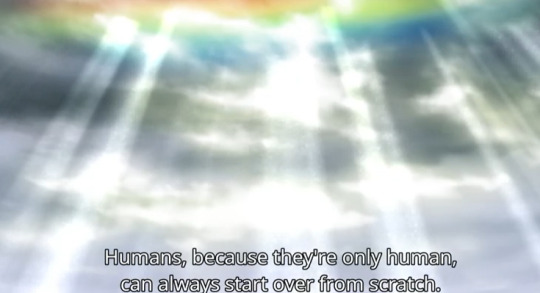
Everything is worthless. Everything will eventually lost. However, because of this it also means that you’re never going to lose something that will destroy you permanently. Because the things you were holding onto were worthless in the first place, you can always try to replace them. You can always try again and find something else. There is no ending that will permanently end you, there’s no loss you cannot suffer. Araragi is not really that important to Nadeko, she can live without him, she was only giving him that importance. This is also the compelte and exact opposite of Iichan’s a fatal would speech.
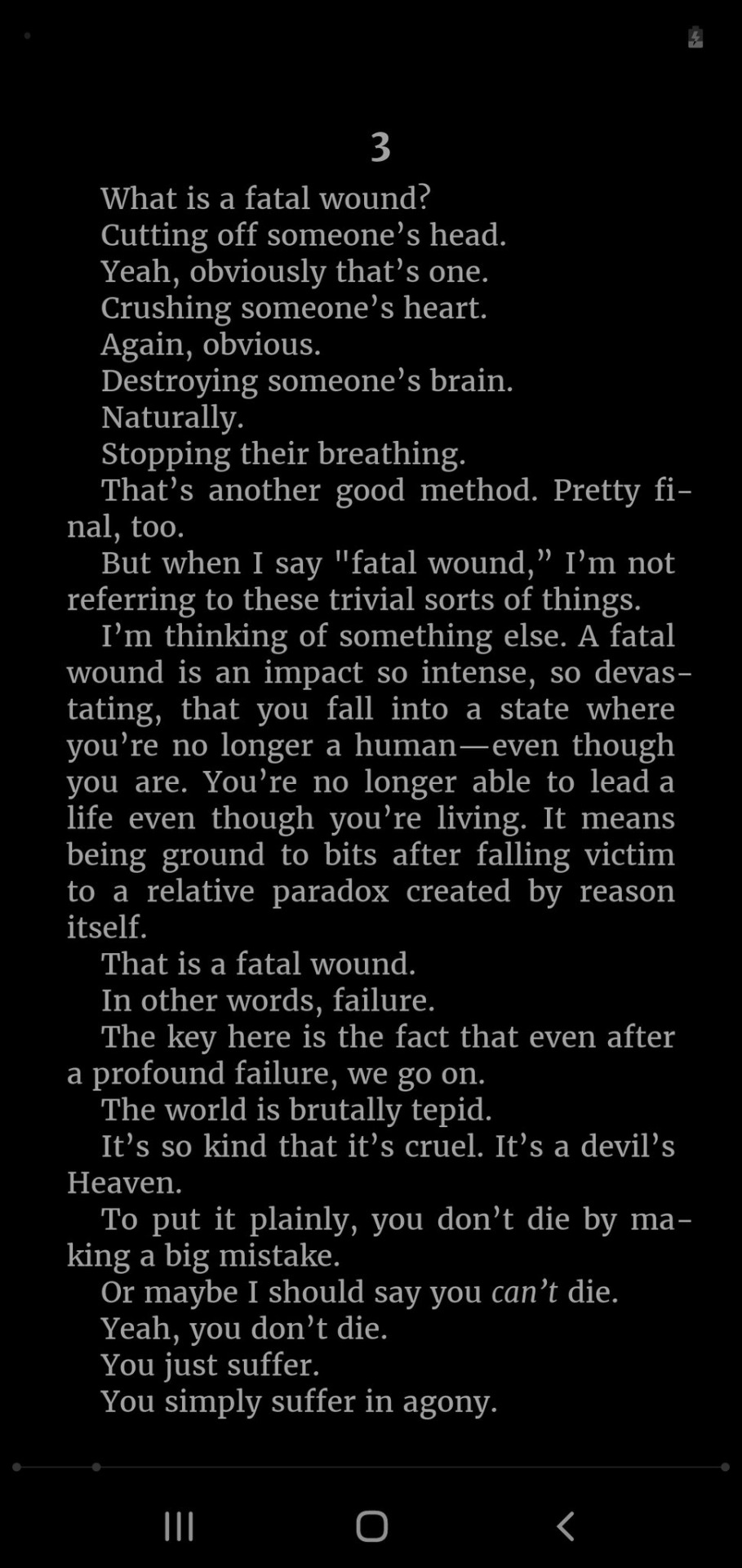
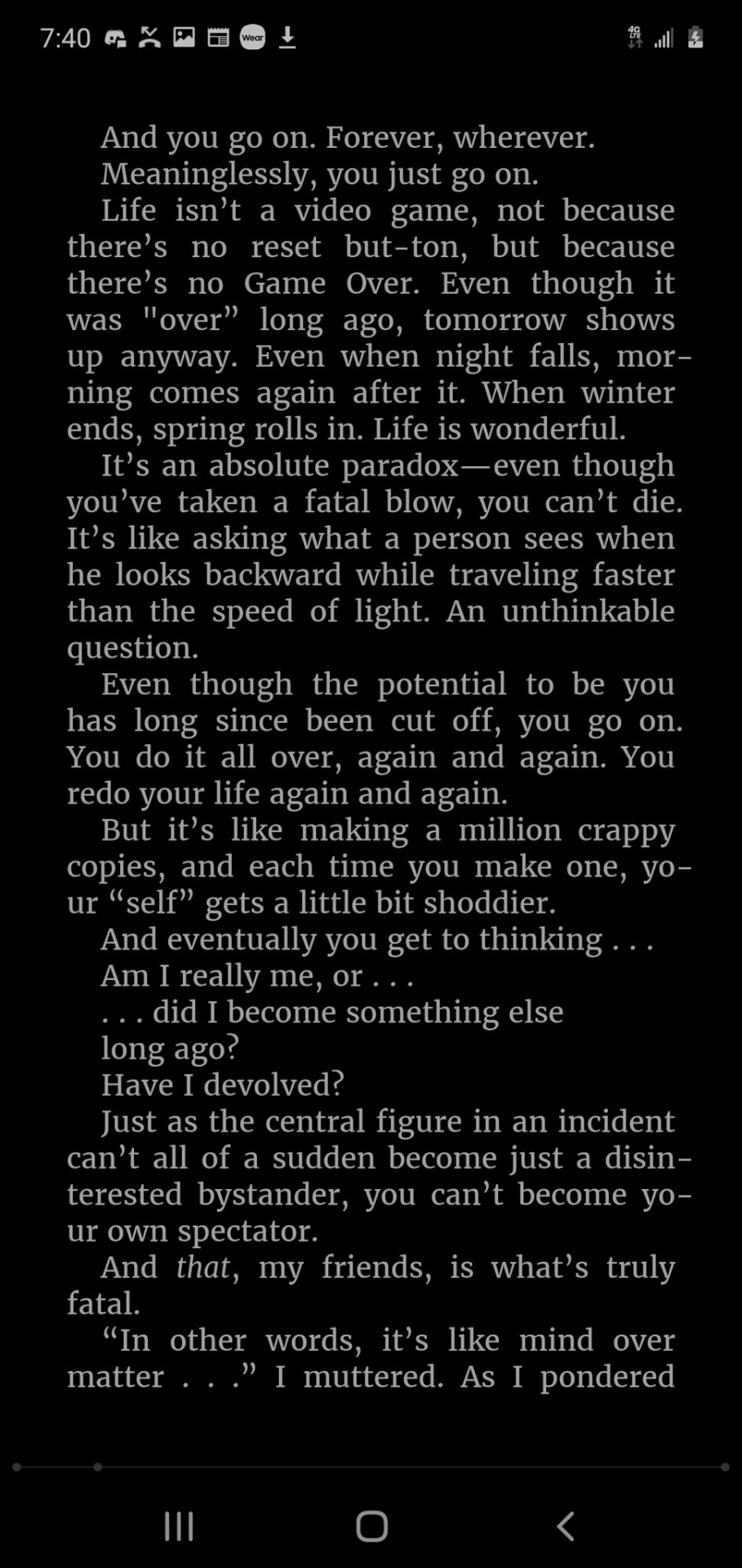
Iichan is someone so terribly afraid to hold onto anything, because he feels the process of trying over and over again at something he’ll never succeed at is going to completely destroy him.
And Kaiki would tell Iichan the same way that he tells Nadeko that him constantly stumbling over his own actions and trying to find meaning in them, is something in itself that has meaning. That's what makes him human, his search for meaning. But philosophically Iichan isn't there yet. He's still a little baby nihilist. Tiny. Infant. He hasn't grown up yet.
“A man devoid of hope and conscious of being so has ceased to belong to the future.” “The struggle itself towards the heights is enough to fill a man's heart.
One must imagine Sisyphus happy
[Albert Camus]
So if you were to put iichan at one end as the baby nihilist, and Kaiki as the adult (kind of) nihilist then the adolescent Kumagawa would be right in the middle. That’s the way to compare the three, Kaiki is a mature adult who has figured out the way he wants to live his life, Kumagawa is someone constantly in flux like an adolescent, desperately struggling to reach the point where Kaiki is where he’s decided how he’s going to live and not quite there yet and therefore always doubting himself. Finally, Iichan is a child who wants to cling onto his immaturity and his completely wrong views of the world because he doesn’t want to face them or have to change. All three of them are liars, and but the lies they tell are different and that brings us to the end of this comparison.
79 notes
·
View notes
Text
Tom and Sybil (Okaria et Feria)

Tom is now 20 years old and has lived hell of a life between the abuse and manipulation from his mother. One year ago, when his dad died, he was able to gather the money left from his dad. Even his mom couldn’t stop that. He was able to flee from his mom’s home and bought a flat. However, his past and his PTSD still torments him to this day. Hopefully, Sybil (an angel) takes responsibility and is gonna help him to build a better life. One he can be happy to have. He also knows Lea because they both go to the same martial art club. He is currently studying medicine to become a doctor or a physicist.

Sybil is an young and promising angel. She is 200 years old and she works as a guardian angel. Guardian angels are assigned to a mortal (human or not) who has a very unhappy life to guide them through a better path. She also works in the purgatory and in the heaven library. She is serious and she is dedicated to her work. She uses to follow the rules and laws until she saw the ineffective result with Tom. She decided to break one of the heaven rules to she could directly help Tom. She has lots of potential for the future of the heaven. She was trained by Raphael while Michael taught her about cultures and diplomacy and Gabriel taught her the rules and laws of the universe and of heaven. Arael (Nazeel’s father) taught her about hell and how it’s organised. She is a friend of Vylixia and Colan since she met them when they were having lessons for the purgatory jobs (Purgatory is a neutral zone where angels and demons share the knowledge and tend to know each other).
Both references wre drawn by the amazing @wildstarfan <3 please support her :D
Tom and Sybil belong to me
Okaria et Feria belongs to me and @wildstarfan
14 notes
·
View notes
Text

Lessons In Humanity From A Future Physicist | Novel by @morgan-s-writes | art by @aelenko
i had the absolute pleasure of reading this book after thinking about it for months, and i can tell you right now that i’ll keep thinking about for many months more! it is such a heartfelt, moving, beautiful story, and the relationship between these two characters blew me away!
#art#artist#space#digital art#drawing#novel#other’s ocs#other’s wips#lessons in humanity from a future physicist
12 notes
·
View notes